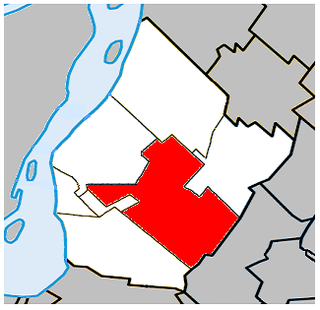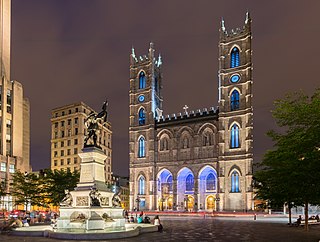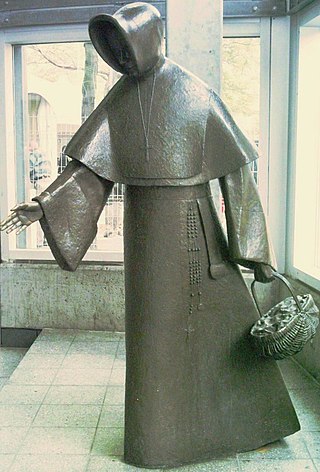
Saint-Hubert is a borough in the city of Longueuil, located in the Montérégie region of Quebec, Canada. It had been a separate city prior to January 1, 2002, when it along with several other neighbouring south shore municipalities were merged into Longueuil. Saint-Hubert had a population of 78,336 in 2006. The area of the borough is 65.98 km2 (25.48 sq mi). Longueuil's city hall is now located in Saint-Hubert. Saint-Hubert is located about 14 kilometres (8.7 mi) from downtown Montreal.

The Congregation of Holy Cross, abbreviated CSC, is a Catholic clerical religious congregation of pontifical rite for men founded in 1837 by Basil Moreau, in Le Mans, France.

Verdun is a borough (arrondissement) of the city of Montreal, Quebec, located in the southwestern part of the island.
Pointe-Saint-Charles is a neighbourhood in the borough of Le Sud-Ouest in the city of Montreal, Quebec, Canada. Historically a working-class area, the creation of many new housing units, the recycling of industrial buildings into business incubators, lofts, and condos, the 2002 re-opening of the canal as a recreation and tourism area, the improvement of public spaces, and heritage enhancement have all helped transform the neighbourhood and attract new residents. Community groups continue to be pro-active in areas related to the fight against poverty and the improvement of living conditions.

Nuns' Island is an island located in the Saint Lawrence River that forms a part of the city of Montreal, Quebec. It is part of the borough of Verdun.

The Redemptorists officially named the Congregation of the Most Holy Redeemer, abbreviated CSsR, is a Catholic clerical religious congregation of pontifical right for men. It was founded by Alphonsus Liguori at Scala, Italy, for the purpose of labouring among the neglected country people around Naples. It is dedicated to missionary work and they minister in more than 100 countries. Members of the congregation are Catholic priests and consecrated religious brothers.

Le Sud-Ouest is a borough (arrondissement) of the city of Montreal, Quebec, Canada.

Marguerite Bourgeoys, CND, was a French nun and founder of the Congregation of Notre Dame of Montreal in the colony of New France, now part of Québec, Canada.
Patrick Phelan, was a Canadian Roman Catholic priest, Sulpician, and Bishop of Kingston briefly in 1857.
The Sisters of Holy Cross, headquartered in Montreal, Quebec, Canada is an international Catholic congregation of religious sisters which traces its origins to the foundation of the Congregation of Holy Cross in 1837 in Le Mans, France by the Blessed Father Basil Anthony-Marie Moreau, CSC. Two other congregations of sisters also have the same origins: the Marianites of Holy Cross and the Sisters of the Holy Cross.

The Notre-Dame-de-Bon-Secours Chapel is a church in the district of Old Montreal in Montreal, Quebec. One of the oldest churches in Montreal, it was built in 1771 over the ruins of an earlier chapel. The church is located at 400 Saint Paul Street East at Bonsecours Street, just north of the Bonsecours Market in the borough of Ville-Marie.

The Congrégation de Notre Dame (CND) is a religious community for women founded in 1658 in Ville Marie (Montreal), in the colony of New France, now part of Canada. It was established by Marguerite Bourgeoys, who was recruited in France to create a religious community in Ville Marie. She developed a congregation for women that was not cloistered; the sisters were allowed to live and work outside the convent. The congregation held an important role in the development of New France, as it supported women and girls in the colony and offered roles for them outside the home.
A parochial mission or parish mission is a special pastoral effort in the Catholic Church aimed at preaching to and instructing Catholic followers. These are "home missions" geared toward Catholics, distinguished from apostolic missions to make conversions among non-believers. Such missions may consist of systematic preaching and instruction, extending over a stated number of days, performed by authorized missionaries.

Notre-Dame Basilica is a basilica in the historic district of Old Montreal, in Montreal, Quebec, Canada. The church is located at 110 Notre-Dame Street West, at the corner of Saint Sulpice Street. It is located next to the Saint-Sulpice Seminary and faces the Place d'Armes square.
The timeline of Montreal history is a chronology of significant events in the history of Montreal, Canada's second-most populated city, with about 3.5 million residents in 2018, and the fourth-largest French-speaking city in the world.

The Notre-Dame Church was a church in Old Montreal that stood from 1682 until 1830. From 1821 to 1822, it served as the first cathedral of the Diocese of Montreal.

Émilie Tavernier Gamelin was a Canadian social worker and Roman Catholic religious sister. She is best known as the founder of the Sisters of Providence of Montreal. In 2001 she was beatified by Pope John Paul II.

Vieux-Québec–Cap-Blanc–Colline Parlementaire is one of the 35 districts of the City of Quebec, and one of six that are located in the borough of La Cité-Limoilou. The district is the most visited and toured location in the city. It is in this partly fortified area where the Château Frontenac is found, with its large terrace overlooking the city of Lévis, across the Saint Lawrence River. A large concentration of cafes, tourist shops, restaurants, hotels and inns are situated in the district. In its most recent census count in 2016, Statistics Canada reported that the district had a population of 5,770 residents, whom comprise 1.1% of the city's total population.

Notre Dame de Sainte Croix is a Catholic church located in the city of Le Mans, France. The church gives its name to the neighborhood itself. It was the first site of the Congregation of Holy Cross.


















